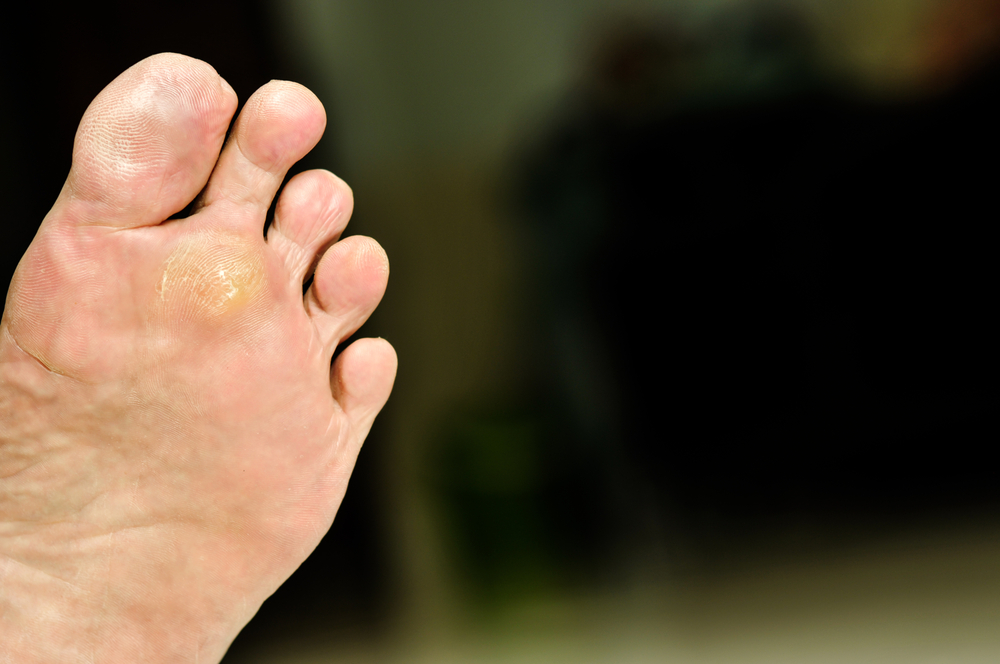
Connellsville


There are many types of foot conditions that primarily impact children. Among them is plantar warts, which primarily targets children. It is estimated that approximately 20% of children that are between the ages of 4 and 12 years old exhibit plantar warts. If your child has plantar warts, you might consider taking them to a podiatrist who will be able to determine how to address the problem. It is possible that the podiatrist might recommend any number of treatment options. For example, there are several treatments available for plantar warts that contain salicylic acid agents. Importantly, it is thought that salicylic acid is generally helpful in mitigating or treating plantar warts. Additionally, liquid nitrogen and dimethyl ether are thought to be other helpful substances for treating plantar warts. If your child has plantar warts, it is suggested that you schedule an appointment with a podiatrist today.
Plantar warts can be very uncomfortable. If you need your feet checked, contact Dr. Arnold Tarpley, Jr. from Tarpley Foot and Ankle Center. Dr. Tarpley will assist you with all of your foot and ankle needs.
About Plantar Warts
Plantar warts are the result of HPV, or human papillomavirus, getting into open wounds on the feet. They are mostly found on the heels or balls of the feet.
While plantar warts are generally harmless, those experiencing excessive pain or those suffering from diabetes or a compromised immune system require immediate medical care. Plantar warts are easily diagnosed, usually through scraping off a bit of rough skin or by getting a biopsy.
Symptoms
Treatment
To help prevent developing plantar warts, avoid walking barefoot over abrasive surfaces that can cause cuts or wounds for HPV to get into. Avoiding direct contact with other warts, as well as not picking or rubbing existing warts, can help prevent the further spread of plantar warts. However, if you think you have developed plantar warts, speak to your podiatrist. He or she can diagnose the warts on your feet and recommend the appropriate treatment options.
If you have any questions please feel free to contact one of our offices located in Uniontown, and Connellsville, PA . We offer the newest diagnostic and treatment technologies for all your foot and ankle needs.

A common reason for heel pain among active children and young teenagers is Sever's disease. The medical name for this condition is calcaneal apophysitis, and it affects the growth plate in the heel. Sever’s disease occurs during a growth spurt in this age group, where additional pressure is put on the heel, especially during the beginning of a new sporting season. The heel bone can grow at a faster speed than the tendons and muscles, and this can cause the heel to become less flexible. Common symptoms many children experience with this ailment can include heel pain and swelling, often causing the need to temporarily stop the activity that caused the condition. There may be additional reasons why Sever’s disease can develop, consisting of having one leg that is shorter than the other, or if the arches are abnormal. Relief can begin by frequently elevating the affected foot which may alleviate some of the swelling, and performing specific stretches that can strengthen the foot. If your child is afflicted with Sever’s disease, it is strongly urged that a podiatrist is consulted who can offer correct treatment methods.
Sever's disease often occurs in children and teens. If your child is experiencing foot or ankle pain, see Dr. Arnold Tarpley, Jr. from Tarpley Foot and Ankle Center. Dr. Tarpley can treat your child’s foot and ankle needs.
Sever’s Disease
Sever’s disease is also known as calcaneal apophysitis, which is a medical condition that causes heel pain I none or both feet. The disease is known to affect children between the ages of 8 and 14.
Sever’s disease occurs when part of the child’s heel known as the growth plate (calcaneal epiphysis) is attached to the Achilles tendon. This area can suffer injury when the muscles and tendons of the growing foot do not keep pace with bone growth. Therefore, the constant pain which one experiences at the back of the heel will make the child unable to put any weight on the heel. The child is then forced to walk on their toes.
Symptoms
Acute pain – Pain associated with Sever’s disease is usually felt in the heel when the child engages in physical activity such as walking, jumping and or running.
Highly active – Children who are very active are among the most susceptible in experiencing Sever’s disease, because of the stress and tension placed on their feet.
If you have any questions, please feel free to contact one of our offices located in Uniontown, and Connellsville, PA . We offer the newest diagnostic and treatment technologies for all your foot and ankle injuries.

A broken toe can wreak havoc while attempting to complete daily activities, and it may happen for various reasons. These can include stubbing it into a piece of furniture, which is generally the pinky toe, or from dropping a heavy object on it. Most people experience immediate pain, bruising, and swelling with a broken toe, and promptly seek medical attention. If the fracture is mild, the buddy taping method may work well. This is done by taping the broken toe to the toe next to it, which is generally successful in providing the stability that is needed as the healing process occurs. It is beneficial to stay off of the foot as much as possible, and frequently elevating it may reduce some of the swelling. If the break is severe, a bone may protrude from the toe, piercing the skin, and it may look deformed. This type of fracture needs immediate medical attention from a podiatrist, and it is suggested that you contact this type of doctor who can diagnose and treat your broken toe accordingly.
A broken toe can be very painful and lead to complications if not properly fixed. If you have any concerns about your feet, contact Dr. Arnold Tarpley, Jr. from Tarpley Foot and Ankle Center. Dr. Tarpley will treat your foot and ankle needs.
What to Know About a Broken Toe
Although most people try to avoid foot trauma such as banging, stubbing, or dropping heavy objects on their feet, the unfortunate fact is that it is a common occurrence. Given the fact that toes are positioned in front of the feet, they typically sustain the brunt of such trauma. When trauma occurs to a toe, the result can be a painful break (fracture).
Symptoms of a Broken Toe
Generally, it is best to stay off of the injured toe with the affected foot elevated.
Severe toe fractures may be treated with a splint, cast, and in some cases, minor surgery. Due to its position and the pressure it endures with daily activity, future complications can occur if the big toe is not properly treated.
If you have any questions please feel free to contact one of our offices located in Uniontown, and Connellsville, PA . We offer the newest diagnostic and treatment technologies for all your foot and ankle needs.

A bunion occurs from repeated stress that happens on the outside of the big toe. Wearing shoes that do not have adequate room for the toes to move freely may cause a bunion. High heels can fall into this category, and it is a condition that is more prevalent among women than men. It is defined as a bony protrusion that develops on the side of the big toe and may cause the other toes to shift toward each other. It is known as a progress foot deformity, and many patients develop bunions for genetic reasons. It is considered to be an imbalance of the muscles and ligaments, where they are either too tight or too loose. The big toe may have a limited range of motion, and walking may be painful. It is common for calluses to form on top of the bunion, and this can be a result of the shoe rubbing against it. In addition to its obvious appearance, an X-ray is often performed that can determine the severity of it. A bunion is a foot condition that is treated by a podiatrist, and if you are afflicted with this, it is suggested you schedule an appointment as quickly as possible so the correct treatment can begin.
If you are suffering from bunion pain, contact Dr. Arnold Tarpley, Jr. of Tarpley Foot and Ankle Center. Dr. Tarpley can provide the care you need to keep you pain-free and on your feet.
What Is a Bunion?
Bunions are painful bony bumps that usually develop on the inside of the foot at the joint of the big toe. As the deformity increases over time, it may become painful to walk and wear shoes. Women are more likely to exacerbate existing bunions since they often wear tight, narrow shoes that shift their toes together. Bunion pain can be relieved by wearing wider shoes with enough room for the toes.
Causes
Symptoms
In order to diagnose your bunion, your podiatrist may ask about your medical history, symptoms, and general health. Your doctor might also order an x-ray to take a closer look at your feet. Nonsurgical treatment options include orthotics, padding, icing, changes in footwear, and medication. If nonsurgical treatments don’t alleviate your bunion pain, surgery may be necessary.
If you have any questions, please feel free to contact one of our offices located in Uniontown, and Connellsville, PA . We offer the newest diagnostic and treatment technologies for all your foot care needs.